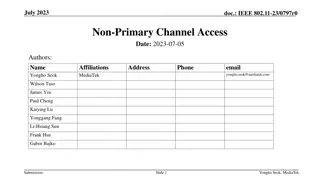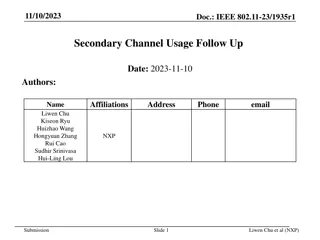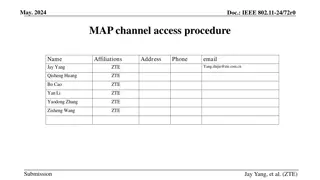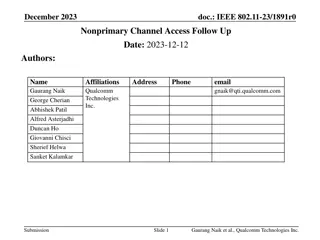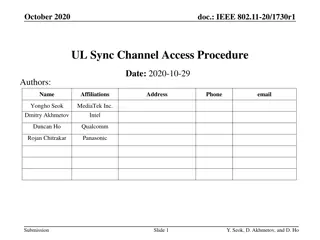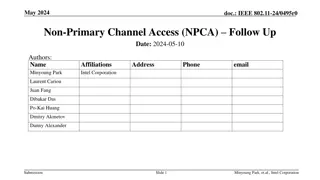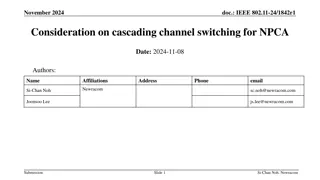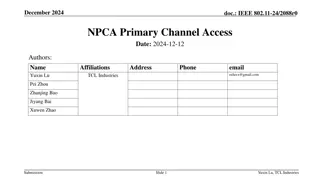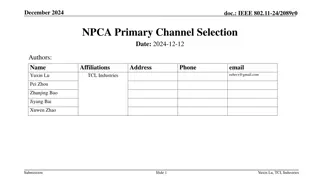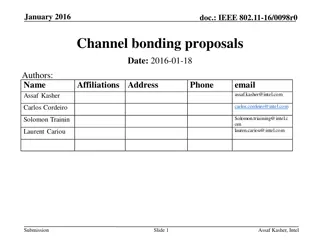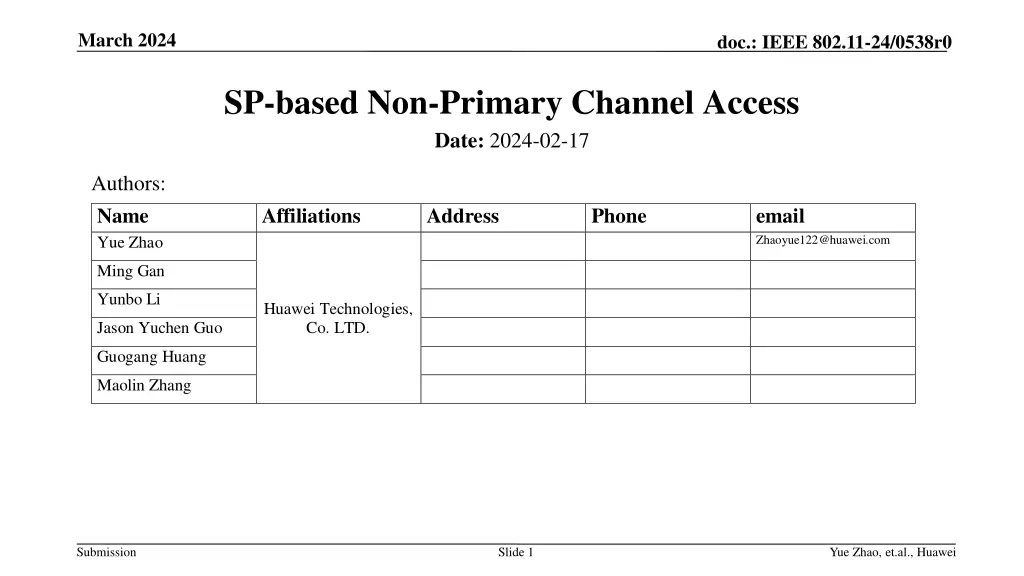
Enhancing Channel Access Efficiency in IEEE 802.11 Networks
Explore SP-based Non-Primary Channel Access for improved efficiency in IEEE 802.11 networks. Understand the motivation, challenges, and proposed solutions for better throughput and latency performance. Dive into the concepts of non-primary channel access and the benefits it offers in reducing collisions and channel congestion during heavy traffic scenarios.
Download Presentation

Please find below an Image/Link to download the presentation.
The content on the website is provided AS IS for your information and personal use only. It may not be sold, licensed, or shared on other websites without obtaining consent from the author. If you encounter any issues during the download, it is possible that the publisher has removed the file from their server.
You are allowed to download the files provided on this website for personal or commercial use, subject to the condition that they are used lawfully. All files are the property of their respective owners.
The content on the website is provided AS IS for your information and personal use only. It may not be sold, licensed, or shared on other websites without obtaining consent from the author.
E N D
Presentation Transcript
March 2024 doc.: IEEE 802.11-24/0538r0 SP-based Non-Primary Channel Access Date: 2024-02-17 Authors: Name Yue Zhao Affiliations Address Phone email Zhaoyue122@huawei.com Ming Gan Yunbo Li Huawei Technologies, Co. LTD. Jason Yuchen Guo Guogang Huang Maolin Zhang Submission Slide 1 Yue Zhao, et.al., Huawei
February 2024 doc.: IEEE 802.11-24/0538r0 Motivation To meet throughput and latency requirements mentioned in the UHR PAR [1], non- primary channel access (NPCA) was proposed as a potential method Existing Techs: Many contributions [2] focus on TXOP-based NPCA To switch to a non-primary channel when OBSS TXOP is detected on the primary channel To switch back to the primary channel when OBSS TXOP on the primary channel ends Reality: OBSSs often use the same primary channel, if the operating channels overlap Heavy traffic is anticipated during TWT SPs => Primary channel becomes very busy during an OBSS TWT SP Frequent switching is anticipated during OBSS TWT SPs Wherein durations on the primary channel might be too shattered to be used => SP-based NPCA is introduced Submission Slide 2 Yue Zhao, et.al., Huawei
February 2024 doc.: IEEE 802.11-24/0538r0 Recap: TXOP-based NPCA With a wider operating channel width and a denser network deployment, channel efficiency is low when only the primary channel access is used With only primary channel access, a STA has to do backoff for transmission if the primary channel is busy, even when non-primary channels are idle. With TXOP-based NPCA, when the primary channel is occupied by an OBSS TXOP, STAs switch to a non-primary channel to contend for the channel, using idle non-primary channels to access the medium, and switch back to the primary channel when the OBSS TXOP ends. BSS TXOP Non-primary channel Switch back to the primary channel Switch to a non-primary channel OBSS TXOP Primary channel Submission Slide 3 Yue Zhao, et.al., Huawei
February 2024 doc.: IEEE 802.11-24/0538r0 Concept: SP-based NPCA With SP-based NPCA, a BSS switches to a non-primary channel to access the medium during an OBSS TWT SP and switches back when SP ends, because It is anticipated that there would be heavy traffic during the TWT SPs OBSSs with staggered parking channels reduce collisions [3] frequency Non-primary channel BSS parking BSS parking Primary channel OBSS TWT SP BSS parking OBSS TWT SP BSS parking time BSS parking Non-primary channel OBSS TWT SP Primary channel Submission Slide 4 Yue Zhao, et.al., Huawei
February 2024 doc.: IEEE 802.11-24/0538r0 Proposal Negotiation Phase: AP and non-AP STAs negotiate parameters used in SP-based NPCA phase Parked non-primary channel, etc. SP-based NPCA Phase: AP and non-AP STAs park on the non-primary channel during OBSS TWT SPs, and park on the primary channel outside OBSS TWT SPs SP-based NPCA Phase Negotiation Phase OBSS TWT SP OBSS TWT SP Non-primary channel BSS parks BSS parks AP announces OBSS TWT Info Primary channel Negotiation Note: Not parked on the subchannel Submission Slide 5 Yue Zhao, et.al., Huawei
February 2024 doc.: IEEE 802.11-24/0538r0 Detail 1. SP-based NPCA Phase For each OBSS TWT Info detected by AP Step 1. AP announces an OBSS TWT Info Step 2. AP and non-AP STAs in a BSS, park on a non-primary channel instead of the primary channel only during OBSS TWT SPs AP and non-AP STAs in a BSS automatically switch to the non-primary channel when an SP starts and automatically switch back to the primary channel when an SP ends OBSS TWT SP BSS parking Non-primary channel Switches back to the primary channel BSS parking BSS switches to a non-primary channel BSS parking AP announces OBSS TWT Info Primary channel Submission Slide 6 Yue Zhao, et.al., Huawei
February 2024 doc.: IEEE 802.11-24/0538r0 Detail 1-1. AP s Announcement of OBSS TWT AP collects OBSS TWT Info via, e.g., Listening to OBSS s beacon, or Information exchange among multiple APs (Multi-AP co-operation) OBSS TWT Info is announced/broadcasted by AP via, e.g., Modified current TWT element, or Defined OBSS TWT element Submission Slide 7 Yue Zhao, et.al., Huawei
February 2024 doc.: IEEE 802.11-24/0538r0 Summary The idea of SP-based NPCA is introduced: A BSS parks on a non-primary channel during OBSS TWT SPs AP and non-AP STAs in the BSS switch to the non-primary channel when an OBSS TWT SP starts, and switch back to the primary channel when the OBSS TWT SP ends Submission Slide 8 Yue Zhao, et.al., Huawei
February 2024 doc.: IEEE 802.11-24/0538r0 Straw Poll Do you support to include SP-based NPCA where a BSS parks on a non- primary channel during OBSS TWT SPs in 11bn SFD? Submission Slide 9 Yue Zhao, et.al., Huawei
February 2024 doc.: IEEE 802.11-24/0538r0 References [1] 11-23/0480r3, UHR proposed PAR, Laurent Cariou [2] 11-23/2005r1, Non-primary channel access (NPCA), Minyoung Park [3] 11-23/2022r1, R-TWT for multi-AP (follow-up), Laurent Cariou Submission Slide 10 Yue Zhao, et.al., Huawei



